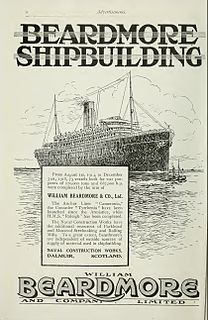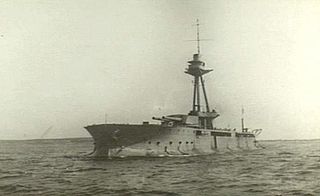
HMS Erebus was a First World War monitor launched on 19 June 1916 and which served in both world wars. She and her sister ship Terror are known as the Erebus class. They were named after the two bomb vessels sent to investigate the Northwest Passage as part of Franklin's Lost Expedition (1845-1848), in which all 129 members eventually perished.

Ship-breaking is a type of ship disposal involving the breaking up of ships for either a source of parts, which can be sold for re-use, or for the extraction of raw materials, chiefly scrap. Modern ships have a lifespan of 25 to 30 years before corrosion, metal fatigue and a lack of parts render them uneconomical to operate. Ship-breaking allows the materials from the ship, especially steel, to be recycled and made into new products. This lowers the demand for mined iron ore and reduces energy use in the steelmaking process. Fixtures and other equipment on board the vessels can also be reused. While ship-breaking is sustainable, there are concerns about the use by poorer countries without stringent environmental legislation. It is also labour-intensive, and considered one of the world's most dangerous industries.

Scrap consists of recyclable materials left over from product manufacturing and consumption, such as parts of vehicles, building supplies, and surplus materials. Unlike waste, scrap has monetary value, especially recovered metals, and non-metallic materials are also recovered for recycling.

HMS Gorgon and her sister ship Glatton were two monitors originally built as coastal defence ships for the Royal Norwegian Navy, as HNoMS Nidaros and Bjørgvin respectively, by Armstrong Whitworth at Elswick. She was purchased from Norway at the beginning of the First World War, but was not completed until 1918 although she had been launched over three years earlier. She engaged targets in Occupied Flanders for the last several months of the war and fired the last shots of the war against such targets on 15 October 1918. She was used as a target ship after several attempts to sell her had fallen through before being sold for scrap in 1928.
Wallsend Slipway & Engineering Company Ltd was formerly an independent company, located on the River Tyne at Point Pleasant, near Wallsend, Tyne & Wear, around a mile downstream from the Swan Hunter shipyard, with which it later merged.

HMS Terror was an Erebus-class monitor built for the Royal Navy during the First World War in Belfast. Completed in 1916, she was assigned to the Dover Patrol where her primary duties involved bombarding German targets on the coast of occupied Belgium, particularly at the ports of Zeebrugge and Ostend. In October 1917 Terror was hit by three torpedoes, taking severe damage to the bow and had to be towed into Portsmouth for repair. In April 1918 she participated in the Zeebrugge raid and provided gunnery support for the Fifth Battle of Ypres in September of the same year.

John Brown and Company of Clydebank was a Scottish marine engineering and shipbuilding firm. It built many notable and world-famous ships including RMS Lusitania, RMS Aquitania, HMS Hood, HMS Repulse, RMS Queen Mary, RMS Queen Elizabeth and the Queen Elizabeth 2.

William Beardmore and Company was a British engineering and shipbuilding conglomerate based in Glasgow and the surrounding Clydeside area. It was active from 1886 to the mid-1930s and at its peak employed about 40,000 people. It was founded and owned by William Beardmore, later Lord Invernairn, after whom the Beardmore Glacier was named.

The Lion class was a class of six fast battleships designed for the Royal Navy (RN) in the late 1930s. They were a larger, improved version of the preceding King George V class, with 16-inch (406 mm) guns. Only two ships were laid down before the Second World War began in September 1939 and a third was ordered during the war, but their construction was suspended shortly afterwards. The design was modified in light of war experience in 1942, but the two ships already begun were scrapped later in the year.

Scotts Shipbuilding and Engineering Company Limited, often referred to simply as Scotts, was a Scottish shipbuilding company based in Greenock on the River Clyde. In its time in Greenock, Scotts built over 1,250 ships.

HMS Abercrombie was a First World War Royal Navy Abercrombie-class monitor.
HMS Largo Bay was a Bay-class anti-aircraft frigate of the British Royal Navy, named for Largo Bay in Fife.

The BL 18-inch Mk I naval gun was a breech-loading naval rifle used by the Royal Navy during World War I. It was the largest and heaviest gun ever used by the British. Only the Second-World-War Japanese 46 cm/45 Type 94 had a larger calibre, 18.1 inches (46 cm) and lighter shell. The gun was a scaled-up version of the BL 15 inch Mk I naval gun and was developed to equip the "large light cruiser" Furious. Its barrel length of 60' was just 40 calibres, slightly limiting its muzzle velocity.

HMS General Craufurd was the one of eight Lord Clive-class monitors built for the Royal Navy during World War I. Their primary armament was taken from obsolete pre-dreadnought battleships. The ship spent the war in the English Channel bombarding German positions along the Belgian coast as part of the Dover Patrol. She participated in the failed First and Second Ostend Raids in 1918, bombarding the defending coastal artillery as the British attempted to block the Bruges–Ostend Canal. Later that year General Craufurd supported the coastal battles during the Hundred Days Offensive until the Germans evacuated coastal Belgium in mid-October. The ship was decommissioned almost immediately after the war ended the following month, but she was reactivated in 1920 to serve as a gunnery training ship for a year. General Craufurd was sold for scrap in 1921.

HMS General Wolfe, also known as Wolfe, was a Lord Clive-class monitor which was built in 1915 for shore-bombardment duties in the First World War. Her class of eight ships was armed by four obsolete Majestic-class pre-dreadnoughts which had their 12-inch guns and mounts removed, modified and installed in the newly built monitors. Wolfe spent her entire war service with the Dover Patrol, bombarding the German-occupied Belgian coastline, which had been heavily fortified. In the spring of 1918 she was fitted with an 18-inch (457 mm) gun, with which she made the longest-range firing in the history of the Royal Navy - 36,000-yard (20 mi) - on a target at Snaeskerke, Belgium. After the war, she was laid up before being stripped and put up for sale in 1920. She was finally scrapped in 1923.

The Gorgon-class monitors were a class of monitors in service with the Royal Navy during World War I. Gorgon and her sister ship Glatton were originally built as coastal defence ships for the Royal Norwegian Navy, as HNoMS Nidaros and HNoMS Bjørgvin respectively but requisitioned for British use. Gorgon commissioned first, in June 1918 and bombarded German positions and other targets in Occupied Flanders. She fired the last shots of the war by the Royal Navy into Belgium on 15 October 1918. She was offered for sale after the war, but was used as a target ship when there were no takers. She was sold for scrap in 1928. Glatton was destroyed by a magazine explosion only days after she was completed in September 1918 while in Dover Harbour. She remained a hazard to shipping until the wreck was partially salvaged and the remains moved out of the way during 1925–26.
Minna was a 1,544 GRT cargo ship that was built in 1922 by Nylands Verksted, Kristiania, Norway for Swedish owners. In 1934, she was sold and renamed Britt. In 1939, she was captured by the Kriegsmarine and sold to German owners in 1940 and was renamed Leba. In 1945, she was seized by the Allies and passed to the Ministry of War Transport(MoWT). She was renamed Empire Conavon and was sold in 1947 to a British company and was renamed Baltkon. She served until 1959 when she was scrapped.
HMS Fernie was a Type I Hunt-class destroyer built for the Royal Navy completed in mid-1940. She was adopted by the Civil Community of Market Harborough, Leicestershire, as part of the Warship Week campaign in 1942. She has been the only ship in the Royal Navy to carry this name.

HMS Simoom was an S-class destroyer which served with the Royal Navy. Launched on 26 January 1918, the vessel operated as part of the Grand Fleet during the last months of World War I. At the end of the conflict, Simoom was placed in reserve and scrapped on 8 January 1931. The name was reused from an R-class destroyer sunk on 23 January 1917.

The Arrol Gantry was a large steel structure built by Sir William Arrol & Co. at the Harland and Wolff shipyard in Belfast, Ireland. It was built to act as overhead cranes for the building of the three Olympic-class liners.














